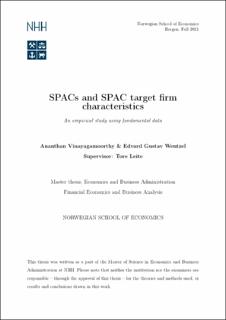SPACs and SPAC target firm characteristics : An empirical study using fundamental data
Master thesis
Permanent lenke
https://hdl.handle.net/11250/2985869Utgivelsesdato
2021Metadata
Vis full innførselSamlinger
- Master Thesis [4372]
Sammendrag
The number of special purpose acquisition (SPACs) companies has boomed in the last few
years and is becoming an impactful factor in the US capital market. Although the concept
is from the 1990s, literature on SPACs remains scarce. Our thesis looks at different
fundamental characteristics of firms going public. We aim to see if firms going public
through a SPAC merger differ from firms going public through the traditional IPO route.
This thesis contributes to the existing literature in two ways. Firstly, we provide a more
sound analysis as we control for the effect of acquired intangible assets that can occur in
a SPAC merger. Secondly, we establish the "earlier stage narrative" as a result of our
findings. This narrative explains that companies choosing to go public through a SPAC
are earlier in a conventional firm’s life cycle than companies choosing the traditional IPO
route when going public.
We use fundamental data from the same year as the companies go public. Our findings
indicate that firms going public through a SPAC are more than 50% smaller than
companies going public through a traditional IPO. Firms that choose to merge with
SPACs are generally portrayed as more technology-oriented. As a proxy to innovation,
we also look into firms’ share of intangible assets and R&D to total assets. However,
we find no significant difference between the two samples. Furthermore, we look at the
firms’ profitability, level of debt, and cash. However, these regressions also result in no
significant difference. Except for size, the two samples seem to have similar fundamental
characteristics.
Combining our findings with the existing literature, it becomes apparent that the structure
of SPACs and the sponsor expertise results in firms being able to go public earlier in their
life cycle. As a result, we formulate the earlier stage narrative, which is not discussed in
the existing literature. We view our narrative as a valuable addition to understanding
what differentiates firms based on their going public method.
